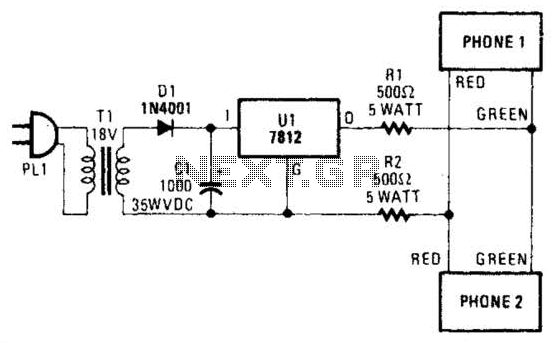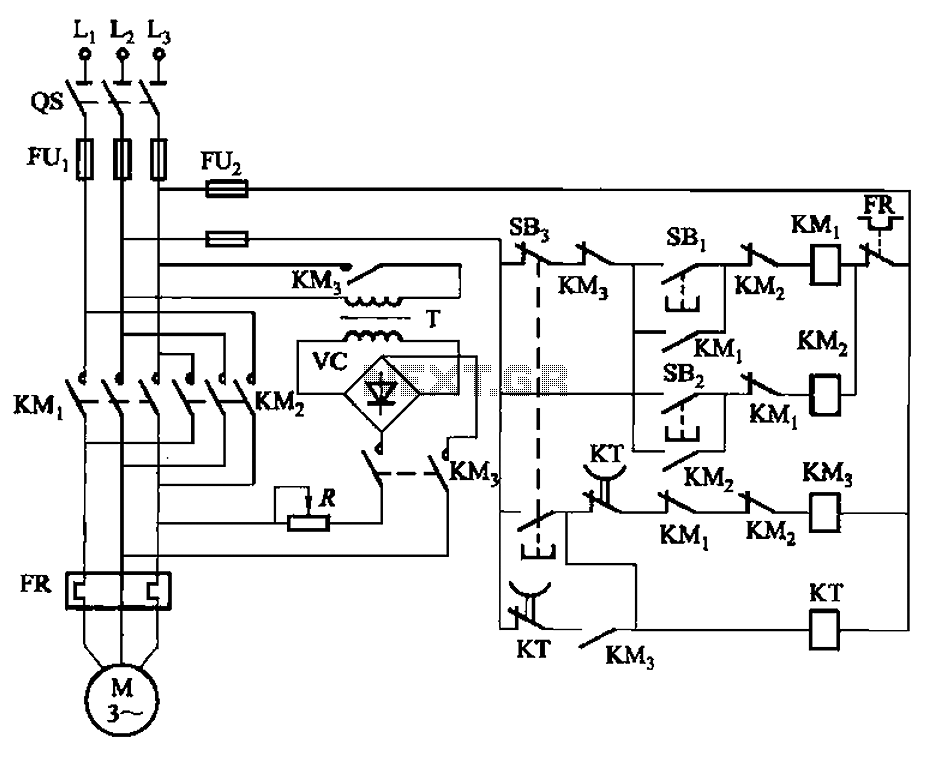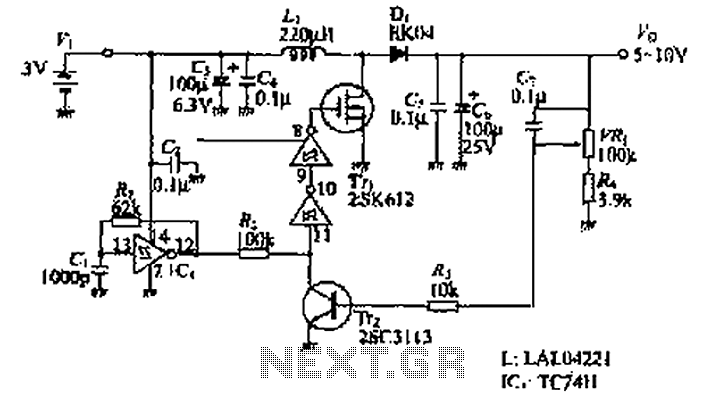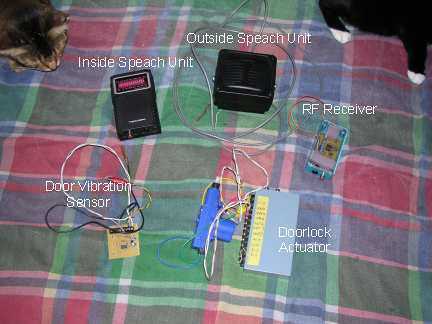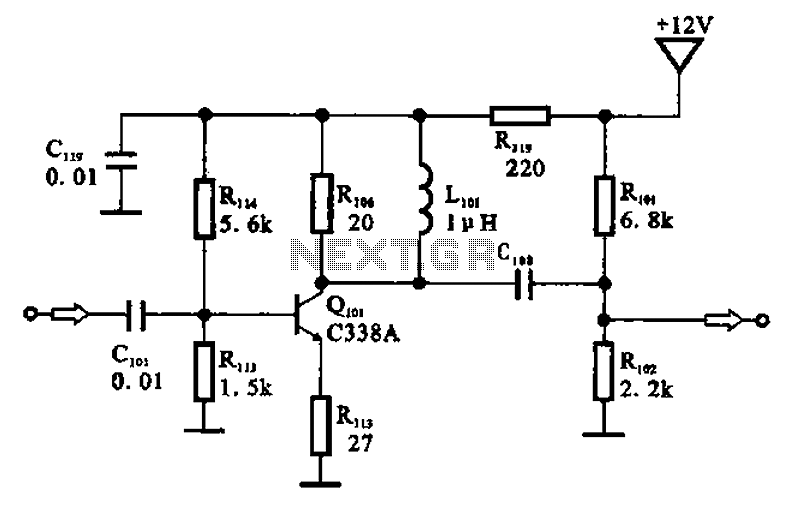
555 Music lantern controller circuit diagram
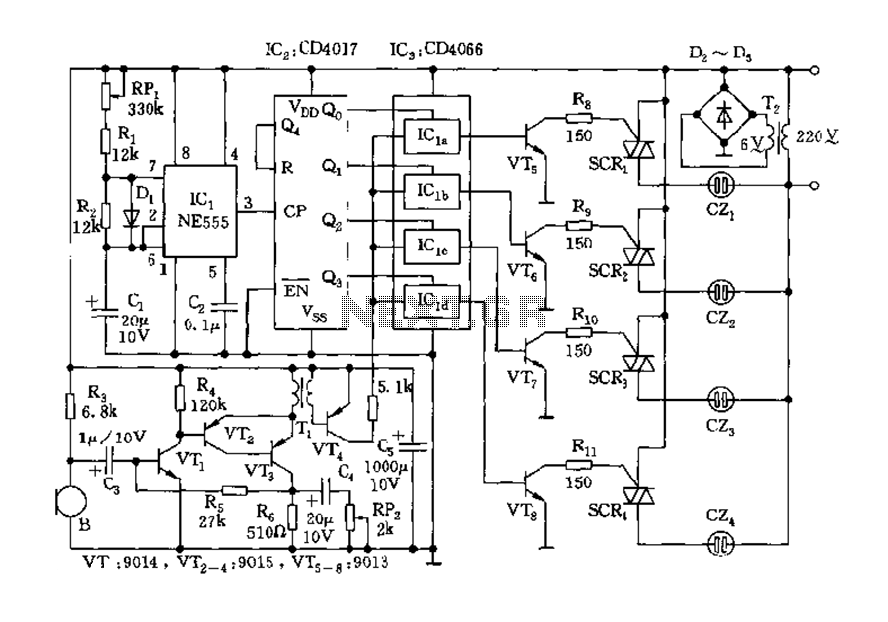
The circuit includes a controller that integrates an acoustic-electric conversion and amplification circuit, a clock pulse generator, a counting circuit, and a control circuit. It manages four accompanying music tracks and flashing lights. Microphones (MIC) convert sound into electrical signals, while VT1 to VT4 function as a quad analog switch using IC3 (CD4066). The 555 timer, along with components RP1, R1, R2, D1, and C1, operates as an astable multivibrator to generate a timing cycle of approximately 0.693(RP1 + R1)C1, with an oscillation period (T) ranging from 0.5 to 5 seconds. The output from pin 3 of the 555 timer is fed into IC2, which serves as a clock pulse (CP) for the CMOS decimal counter/pulse distributor CD4017. Under the action of the clock CP, output Q0 (pin 3), Q1 (pin 2), Q2 (pin 4), Q3 (pin 7), and Q4 (pin 10) produce high-level pulses, with Q4 connected to the reset terminal R (pin 15), effectively creating a ring counter circuit. The outputs Q0 to Q3 sequentially trigger the four analog switches (CD4066) to add strobe signals to the music outputs VT5, VT6, VT7, and VT8, turning on SCR1 to SCR4 in succession. This action powers the lights in a coordinated manner, creating a visual display that complements the melodious music with flashing lights.
The circuit operates by first capturing sound through microphones, which convert acoustic signals into electrical signals for processing. The 555 timer is configured in astable mode, generating a continuous square wave output that serves as a clock signal for the CD4017 counter. The timing components are selected to allow for a flexible oscillation period, which can be adjusted to suit the desired timing of the light and sound synchronization.
The CD4017 counter is a decade counter that counts the clock pulses and activates its outputs sequentially. Each output corresponds to a specific timing interval, allowing for a precise control of the lighting sequence. The connection of the reset terminal allows for the counter to be reset after reaching the maximum count, ensuring that the sequence can repeat indefinitely.
The analog switches (CD4066) are utilized to route the strobe signals to the respective outputs, effectively controlling the activation of the SCRs. These SCRs are used to switch the power to the lights, enabling them to flash in sync with the music. The overall design ensures that the audio and visual elements are harmoniously integrated, providing an engaging experience through synchronized music and lighting effects. The careful selection of components and their configuration allows for a versatile and dynamic performance, suitable for various applications such as entertainment systems, stage performances, or interactive installations.Controller as shown, including the acoustic-electric conversion and amplification circuit, a clock pulse generator, counting circuit and control circuit. It controls four accom panying music and lights flashing light. Microphones MIC song will sound into electrical signals, VT1 ~ VT4 was added to quad analog switch IC3 (CD4066). 555 and RP1, R1, R2, D1, C1 and other components astable multivibrator t charge 0.693 (RP1 + R1) C1 t put 0.693R2C1 T 0.693 (RP1 + R1 + R2) C1 Oscillation period T illustrated parameters vary within the range of 0.5 to 5 seconds.
3-pin output 555 added to the IC2 as a CP pulse. IC2 using CMOS type decimal counter/pulse distributor CD4017, under the clock CP action, Q0 (3 feet), Q1 (2 feet), Q2 (4 feet) Q3 (7 feet), Q4 (10 feet) high power have emerged level pulse, and Q4 was added to a reset terminal R (15 feet), the circuit becomes a ring counter circuit. Output Q0 ~ Q3 will in turn four analog switches CD4066 strobe signal sequentially added to the Song VT5, VT6, VT7, VT8, and sequentially turned on, SCR1 ~ SCR4 turn trigger conduction, followed by a power socket lights, lanterns order lights, with melodious music, lights flashing brilliance.
The circuit operates by first capturing sound through microphones, which convert acoustic signals into electrical signals for processing. The 555 timer is configured in astable mode, generating a continuous square wave output that serves as a clock signal for the CD4017 counter. The timing components are selected to allow for a flexible oscillation period, which can be adjusted to suit the desired timing of the light and sound synchronization.
The CD4017 counter is a decade counter that counts the clock pulses and activates its outputs sequentially. Each output corresponds to a specific timing interval, allowing for a precise control of the lighting sequence. The connection of the reset terminal allows for the counter to be reset after reaching the maximum count, ensuring that the sequence can repeat indefinitely.
The analog switches (CD4066) are utilized to route the strobe signals to the respective outputs, effectively controlling the activation of the SCRs. These SCRs are used to switch the power to the lights, enabling them to flash in sync with the music. The overall design ensures that the audio and visual elements are harmoniously integrated, providing an engaging experience through synchronized music and lighting effects. The careful selection of components and their configuration allows for a versatile and dynamic performance, suitable for various applications such as entertainment systems, stage performances, or interactive installations.Controller as shown, including the acoustic-electric conversion and amplification circuit, a clock pulse generator, counting circuit and control circuit. It controls four accom panying music and lights flashing light. Microphones MIC song will sound into electrical signals, VT1 ~ VT4 was added to quad analog switch IC3 (CD4066). 555 and RP1, R1, R2, D1, C1 and other components astable multivibrator t charge 0.693 (RP1 + R1) C1 t put 0.693R2C1 T 0.693 (RP1 + R1 + R2) C1 Oscillation period T illustrated parameters vary within the range of 0.5 to 5 seconds.
3-pin output 555 added to the IC2 as a CP pulse. IC2 using CMOS type decimal counter/pulse distributor CD4017, under the clock CP action, Q0 (3 feet), Q1 (2 feet), Q2 (4 feet) Q3 (7 feet), Q4 (10 feet) high power have emerged level pulse, and Q4 was added to a reset terminal R (15 feet), the circuit becomes a ring counter circuit. Output Q0 ~ Q3 will in turn four analog switches CD4066 strobe signal sequentially added to the Song VT5, VT6, VT7, VT8, and sequentially turned on, SCR1 ~ SCR4 turn trigger conduction, followed by a power socket lights, lanterns order lights, with melodious music, lights flashing brilliance.
